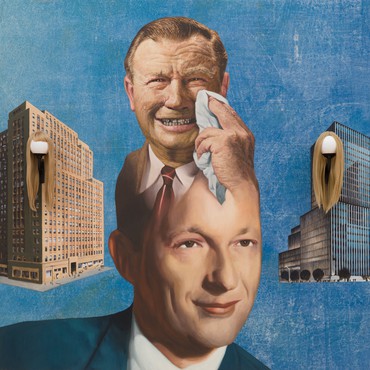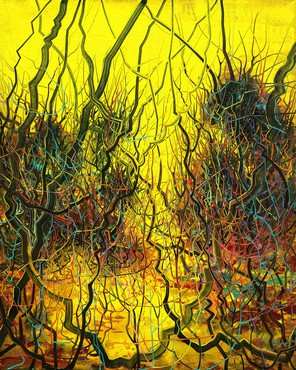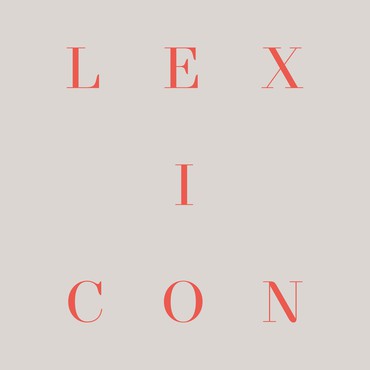About
Skin has become inadequate in interfacing with reality. Technology has become the body’s new membrane of existence.
—Nam June Paik
Nam June Paik (1932–2006) brought the television to fine art, treating it as a tactile and multisensory medium and object. Trained as a classical pianist, he came into contact with protagonists of the counterculture and avant-garde movements of the 1960s through his early interests in composition and performance, and this engagement profoundly shaped his outlook at a time when electronic images were becoming increasingly present in everyday life. His groundbreaking work is considered seminal to the development of video art.
Born in Seoul, Paik fled with his family in 1950 to escape the Korean War, traveling first to Hong Kong and then to Japan. After graduating from the University of Tokyo in 1956, he moved to West Germany to continue his studies. There he met the composers Karlheinz Stockhausen and John Cage, as well as the conceptual artists George Maciunas and Joseph Beuys, all of whom deeply affected his thoughts on performance. He joined the Fluxus group in 1962 and moved from the manual manipulation of audiotapes to experimenting with television sets and their screens. Two years later, by this time living in New York, Paik met the cellist Charlotte Moorman, a central figure of the city’s avant-garde, and the two began a collaboration that would last until her death in 1991. Paik created many of his most well-known works for Moorman, including TV Bra for Living Sculpture (1969) and TV-Cello (1971).
Prior to moving to the United States, Paik had met the engineer Shuya Abe, who would also become a longtime collaborator as well as his assistant. Abe helped Paik make his first robot, Robot K-456, in 1964. Composed of metal fragments, fabric, a data recorder, and a loudspeaker that plays recordings of speeches by John F. Kennedy, Robot K-456 captures Paik’s interest in merging popular media and technology with human traits; possessing abstracted breasts and penis, it moves on wheels and is programmed to periodically defecate beans. Paik showed this remote-controlled robot in several exhibitions and performances in New York throughout the 1960s. In 1982, during his first major museum exhibition at the Whitney Museum of American Art, he took Robot K-456 out into the street to orchestrate an “accident”: the robot walked down Madison Avenue and was hit by a car as it attempted to cross 75th Street. For Paik, this spectacle represented a “catastrophe of technology in the twentieth century.”
Alongside his robotic works, Paik maintained a dynamic drawing practice, both in works on paper and in multimedia sculptures and installations. His modified television sets, in particular, combine the moving image with the free, expressive gesture of abstraction; using brightly colored markers, paints, and other materials, Paik would add expressive layers to the screens. Lion (2005), a monumental assemblage comprising twenty-eight television screens and a hand-painted guardian lion sculpture framed within a wooden arch, displays fast-paced montages of flowers, animals, and fish, as well as footage of lions and Merce Cunningham dancing. Lion is emblematic of Paik’s late style, in which he often reflected upon the many artists and performers who influenced his oeuvre.

Photo: Sueddeutsche Zeitung Photo/Alamy Stock Photo
#NamJunePaik
Exhibitions
Nam June Paik: Art in Process: Part One
On the occasion of Nam June Paik: Art in Process: Part One, curator John G. Hanhardt and Nam June Paik Estate curator Jon Huffman discuss the survey of works spanning the artist’s career.

Reading Nam June Paik
Earlier this year, MIT Press released We Are in Open Circuits: Writings by Nam June Paik. Here Gregory Zinman, coeditor of the book along with John Hanhardt and Edith Decker-Phillips, writes about his first exposure to the artist’s archives, the discoveries made there, and the relationship between Paik’s writings and his larger practice.
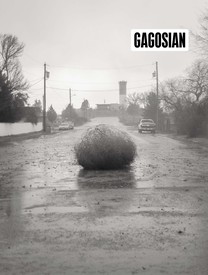
Now available
Gagosien Quarterly Winter 2019
The Winter 2019 issue of Gagosien Quarterly is now available, featuring a selection from Christopher Wool’s Westtexaspsychosculpture series on its cover.

Time by Dance by Paik
Gillian Jakab considers the role of choreography in Nam June Paik’s 1989 video installation Fin de Siècle II.

Life and Technology: The Binary of Nam June Paik
Alexander Wolf explores the intersection of life and technology as it exists in the work of Nam June Paik, revealing the artist’s ability to balance technological concerns with humanity through music, performance, expressive painting, and images from nature.
Fairs, Events & Announcements
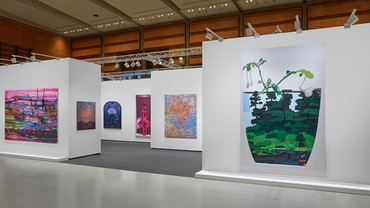
Art Fair
Frieze Seoul 2023
September 7–9, 2023, booth C14
COEX, Seoul
www.frieze.com
Gagosien is pleased to participate in Frieze Seoul 2023 with a presentation of contemporary works by gallery artists, including Derrick Adams, Georg Baselitz, Dan Colen, Edmund de Waal, Jadé Fadojutimi, Urs Fischer, Cy Gavin, Mehdi Ghadyanloo, Nan Goldin, Katharina Grosse, Jennifer Guidi, Thomas Houseago, Alex Israel, Rick Lowe, Takashi Murakami, Nam June Paik, Giuseppe Penone, Ed Ruscha, Alexandria Smith, Anna Weyant, Stanley Whitney, Jonas Wood, and Richard Wright, among others.
Coinciding with the fair is the arrival of Jiyoung Lee, who was recently appointed to lead the gallery’s operations in Korea. Lee joins Gagosien following nearly fifteen years based in Seoul working on behalf of both Korean and Western galleries. Her appointment builds on the gallery’s establishment of a business entity in Korea last year, and provides for expanded activities in the region.
Gagosien’s booth at Frieze Seoul 2023. Artwork, left to right: © Jadé Fadojutimi, © Jen Guidi, © Alexandria Smith, © Mehdi Ghadyanloo, © Rick Lowe Studio, © Jonas Wood, Photo: Sebastiano Pellion di Persano
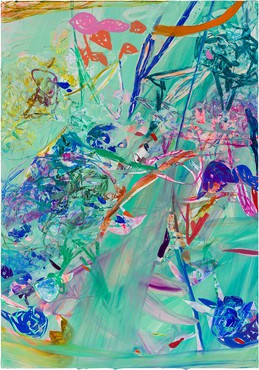
Art Fair
Art Basel Hong Kong 2023
March 22–25, 2023
Hong Kong Convention and Exhibition Centre
www.artbasel.com
Gagosien is pleased to participate in Art Basel Hong Kong 2023 with a presentation of modern and contemporary works by international artists.
Jadé Fadojutimi, As usual, the season’s showers tend to linger, 2023 © Jadé Fadojutimi
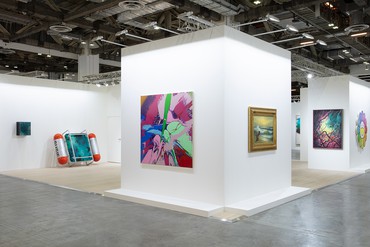
Art Fair
ART SG
January 12–15, 2023, booth BF05
Marina Bay Sands Expo and Convention Centre, Singapore
artsg.com
Gagosien is pleased to announce the gallery’s participation in the inaugural edition of ART SG, with a selection of works by international contemporary artists including Banksy, Georg Baselitz, Ashley Bickerton, Edmund de Waal, Helen Frankenthaler, Katharina Grosse, Mark Grotjahn, Damien Hirst, Howard Hodgkin, Thomas Houseago, Tetsuya Ishida, Alex Israel, Jia Aili, Harmony Korine, Takashi Murakami, Nam June Paik, Giuseppe Penone, Ed Ruscha, Spencer Sweeney, Sarah Sze, Tatiana Trouvé, Anna Weyant, Jonas Wood, and Zeng Fanzhi.
Gagosien’s booth at ART SG 2023. Artwork, left to right: © Ashley Bickerton; © Damien Hirst and Science Ltd. All rights reserved, DACS 2022; © Banksy; © Zeng Fanzhi; © 2020 Takashi Murakami/Kaikai Kiki Co., Ltd. All rights reserved. Photo: Sebastiano Pellion di Persano
Museum Exhibitions

Closed
The Dream of the Museum
November 11, 2021–April 23, 2023
M+, Hong Kong
www.mplus.org.hk
The Dream of the Museum examines the concept of found objects to show how artists use cultures as source material to update tradition. Beginning with four pioneers of contemporary art—Marcel Duchamp, John Cage, Yoko Ono, and Nam June Paik—the exhibition brings together work by twenty-seven artists from across geographies and generations, including Hao Liang and Andy Warhol, who explore chance and found objects in their work.
Hao Liang, Eight Views of Xiaoxiang—Dazzle, 2015 © Hao Liang. Photo: courtesy UCCA Center for Contemporary Art, Beijing

Closed
America. Entre rêves et réalités
La collection du Hirshhorn Museum and Sculpture Garden Collection
June 9–September 11, 2022
Musée national des beaux-arts du Québec, Canada
www.mnbaq.org
Featuring more than a hundred paintings, photographs, sculptures, and video works drawn from the permanent collection of the Hirshhorn Museum and Sculpture Garden in Washington, DC, this exhibition, whose title translates to America. Between Dreams and Realities, offers a broad overview of modern and contemporary American art. Organized thematically, it looks carefully and critically at the notion of the American dream and uncovers how artists have variously grappled with questions of identity, the challenges of globalization, the realities of everyday life in America, and the complexities of its technological and political revolutions. Work by Alexander Calder, Willem de Kooning, Helen Frankenthaler, Sally Mann, Man Ray, Brice Marden, Nam June Paik, Ed Ruscha, Andy Warhol, and Mary Weatherford is included.
Mary Weatherford, Engine, 2014, Hirshhorn Museum and Sculpture Garden, Washington, DC © Mary Weatherford. Photo: Fredrik Nilsen Studio

Closed
Nam June Paik
The Future Is Now
December 10, 2021–March 27, 2022
National Gallery Singapore
www.nationalgallery.sg
This major exhibition brings together more than two hundred works from throughout Nam June Paik’s five-decade career—from robots made from old TV screens, to his innovative video works, and all-encompassing room-size installations. The exhibition looks at his close collaborations with Joseph Beuys, John Cage, Merce Cunningham, Charlotte Moorman, and others. This exhibition originated at the Tate Modern in London.
Nam June Paik, One Candle, 2004 © Estate of Nam June Paik. Photo: Jon Huffman

Closed
Nam June Paik
May 8–October 3, 2021
San Francisco Museum of Modern Art
www.sfmoma.org
This major exhibition brings together more than two hundred works from throughout Nam June Paik’s five-decade career—from robots made from old TV screens, to his innovative video works, and all-encompassing room-size installations. The exhibition looks at his close collaborations with Joseph Beuys, John Cage, Merce Cunningham, Charlotte Moorman, and others. This exhibition originated at the Tate Modern in London.
Nam June Paik, Sistine Chapel, 1993, installation view, Tate Modern, London © Estate of Nam June Paik. Photo: Andrew Dunkley




![Nam June Paik, Untitled [Newspaper Drawing], c. 1990 Oil stick on printed newsprint, 22 ⅝ × 15 ⅛ inches (57.5 × 38.4 cm), Smithsonian American Art Museum, Washington, DC© Nam June Paik Estate](/images/DzSeDVjbRpFH_585x329.jpg)


![Nam June Paik, Untitled [Console RCA Victor Deluxe], 1996 Single-channel video (color, silent) in a vintage television cabinet with acrylic and toy robot, dimensions variable© Nam June Paik Estate](/images/J61yQHklKRVo_585x329.jpg)







![Nam June Paik, Untitled [Cage Composite], 2005 Two-channel video (color, silent) in vintage televisions with electric lights and permanent oil marker, 45 ½ × 21 × 23 ½ inches (115.6 × 53.3 × 59.7 cm)© Nam June Paik Estate](/images/KjKCCY76VS2m_585x329.jpg)










